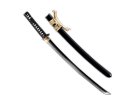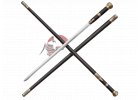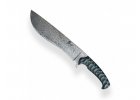Tamahagane is a traditional Japanese steel used to make swords, knives and other cutting tools. It is pure iron that is made from local raw materials - iron sands and carbon. The production of tamahagane steel is very complex and takes several days.
The process of making tamahagane begins with gathering the raw materials, which are then mixed in a certain ratio and put into a large furnace called a tatara. The tatara is then lit and left on the fire for several days to allow the raw materials to slowly melt and combine. During the process, samples of the metal are taken and analysed to ensure quality and carbon content.
After a few days, the tatara is opened and a piece of tamahagane steel is removed. This piece is further treated and cleaned to remove excess impurities and carbon residues. Tamahagane steel has a high carbon content and low impurity content, giving it excellent properties such as hardness, durability and flexibility.
Tamahagane steel is mainly used to make Japanese swords, known as katanas. These swords are made of several layers of steel, with tamahagane forming the core of the sword. This process is called moulding and is very difficult. Swords made from tamahagane are very high quality and durable, but they are also very expensive and difficult to make.
Tamahagane steel is still prized among craftsmen and collectors of knives and swords. It is an important part of Japanese cultural heritage and tradition that has been passed down from generation to generation.

_-_edited.png)































